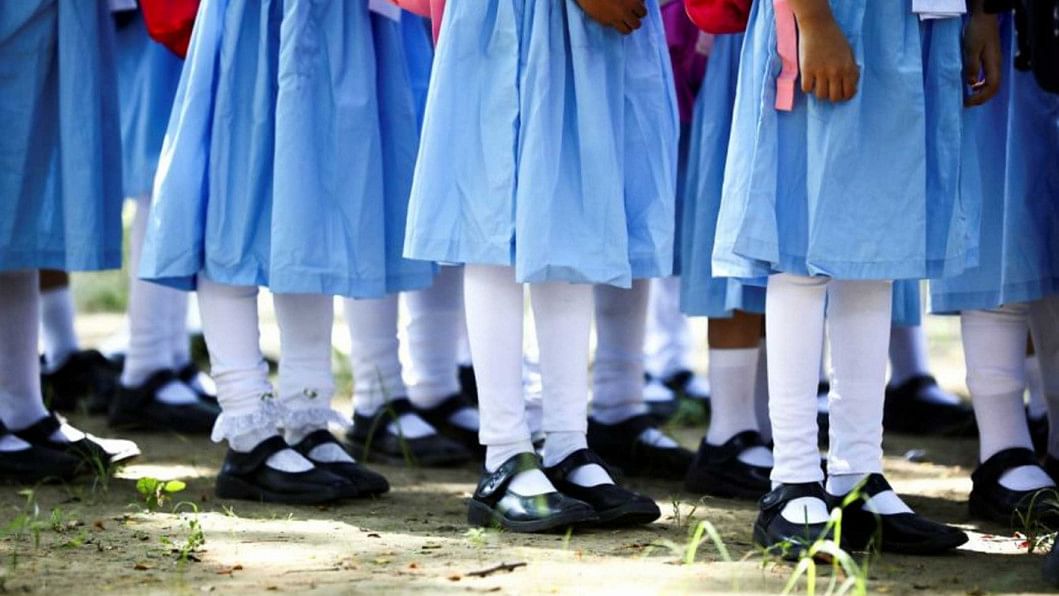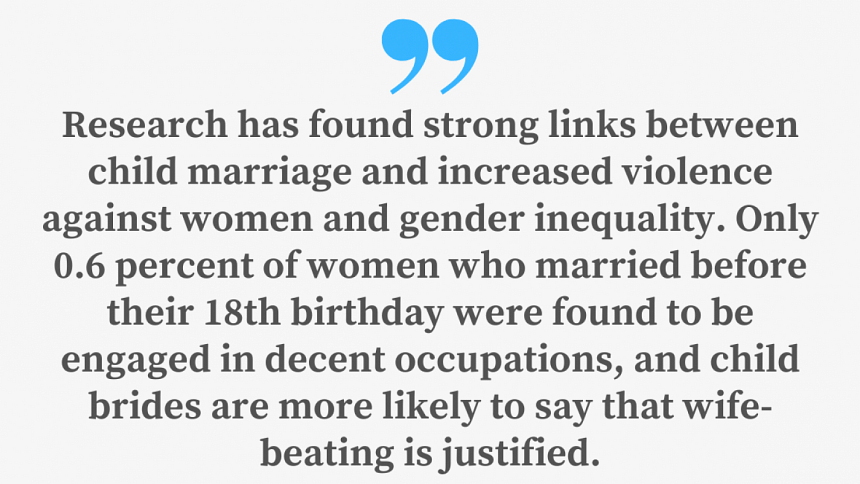Reducing child marriage is crucial for reducing violence against women

Despite strong performances on socioeconomic and population fronts, the incidence of child marriage and associated adolescent fertility rate in Bangladesh is among the highest in the world and the highest in Asia. This is despite the Child Marriage Restraint Act, 2017, and the Ministry of Women and Children Affairs' National Plan of Action to End Child Marriage (2018-2030). It is clear that these efforts have been mostly ineffective in fighting child marriage.
In Bangladesh, the median age of first marriage was 16.3 years in 2018. More than half of women aged 20-24 years were first married before the age of 18, whereas 15 percent were married before turning 15 years old. This scenario has now been exacerbated by the pandemic. According to Manusher Jonno Foundation, during six months of 2020, almost 14,000 girls became victims of child marriage. Around half of them were 13-15 years old.
Against this backdrop, achieving the national target to end child marriage by 2041 will require political will and stronger actions. According to Unicef calculations, the country has to move eight times faster than the rate observed over the past decade to meet this target. In the case of the SDG target to eliminate child marriage by 2030, the country has to move 17 times faster than the present rate of reduction.
There are a number of factors leading to child marriages in the country. Girls with lower education levels, experiencing poverty and having less educated mothers are more likely to be married at a younger age. Similarly, lack of birth documentation, lax enforcement of laws, lack of awareness of rights, gender inequality, and emergencies such as violence and climate change result in child marriage. Child marriages also tend to be concentrated in rural regions and urban slums.
Research has found strong links between child marriage and increased violence against women and gender inequality. Only 0.6 percent of women who married before their 18th birthday were found to be engaged in decent occupations, and it has been suggested that reducing child marriage by 50 percent could get 0.45 million more women employed in high-skilled occupations. Married girls are over four times more likely to be dropouts, and child brides are more likely to say that wife-beating is justified than their peers.
Globally, girls who married before the age of 15 were almost 50 percent more likely to have experienced physical or sexual violence from their partners than those married after 18, disproving the present societal perception that early marriages can protect girls from gender-based violence. Married girls are also more likely to experience multiple pregnancies, recurrent miscarriage, termination of pregnancy, delivery-related complications, and higher rates of child and maternal mortality.

Child marriage is associated with large income and welfare effects as well. According to World Bank analysis from multi-country data, the largest impacts of child marriage in terms of their economic costs tend to be related to fertility and population growth, education and earnings, and the health of the children born to young mothers. For instance, ending child marriage could result in USD 4 trillion in additional income globally due its impact on reducing population growth, under-five mortality and under-five stunting. It will also be accompanied by a 12 percent rise in income and productivity, and a 1.7 percent gain in GDP.
In Bangladesh, averting child marriage would lead to similar economic benefits through a reduction in maternal mortality, infant mortality, child mortality, hospitalisation and inability to work – the total economic benefits in this connection could be USD 33.9 billion.
In contrast, it would take relatively little funding to actually end child marriage.
According to a 2019 UNFPA-Johns Hopkins study, ending 90 percent of child marriages by 2030 would cost USD 35 billion in total, amounting to roughly USD 600 to spare each child from becoming a bride. Various compositions of cash, in-kind payments, and community-based approaches have been moderately successful in preventing child marriages in quite a few countries. Research has also pointed towards the need for complementary interventions to improve quality of schooling, since empowering girls with information, skills and support networks can be a vital strategy in increasing the age of first marriage.
In Bangladesh, the persistent occurrences of child marriage indicate the necessity of an institutionalised approach to address social norms that perpetuate child marriage, in addition to direct interventions. At the same time, there must be effective implementation of the law that makes these marriages illegal. Also, reliable and updated data on child marriage is crucial to ensure timely interventions and informed policymaking.
Reducing child marriage will not only benefit girls and women by saving them from missed education and earning opportunities, pre- and post-natal health risks, and infant mortality rates and malnutrition. It will ultimately lead to enhanced decision-making authority of women in the household and reduce intimate partner violence, which in the long run will benefit the entire country by lowering fertility rates, population growth, and poverty.
Eshrat Sharmin is a senior research associate at Sanem.

 For all latest news, follow The Daily Star's Google News channel.
For all latest news, follow The Daily Star's Google News channel. 






Comments